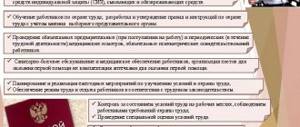Reasons for testing knowledge on labor protection
The inspections are carried out for the following reasons:
- When hiring for a new position, the manager must be trained in occupational safety within the first thirty days of the month.
- Without certification, an official cannot instruct subordinates.
- Requires knowledge of first aid and how to respond to emergency situations, including how to conduct investigations.
Studies
The requirements for studying regulations apply to foremen, site managers, technologists who have subordinates in the department, as well as those involved in the development of technological routes.
Who is undergoing training
Occupational safety training, in accordance with Art. 225 of the Labor Code of the Russian Federation, all employees of the organization, without exception, must undergo:
- managers, including employers - individual entrepreneurs;
- specialists;
- workers.
Those who have not completed training cannot be allowed to perform their job duties.
Important! An employee who has not attended the training course through no fault of his own must be suspended from work, and the organization is obliged to pay for this period as downtime due to the fault of the organization (Parts 1, 3 of Article 76 of the Labor Code of the Russian Federation).
Who conducts knowledge testing of labor protection requirements in the organization
Extraordinary test of knowledge on labor protection
At an enterprise, the organization of occupational safety training is carried out by the personnel department or a training center created at the enterprise. To administer the exams, a commission is created consisting of:
- chairman. This may be the chief engineer or the site manager;
- members of the commission. These are the main specialists, for example, the chief designer, technologist, mechanic, safety specialist or head of the safety department and others.
Important! It is necessary that the number of members, including the chairman, be odd, and they must have certification in the field of Health and Safety.
The company has the right to enter into an agreement with specialized training centers that will deal with this task if it is not possible to maintain a staff. You can take exams by taking tests through a computer program.
What types of checks
Types of occupational safety knowledge tests
When is an extraordinary test of personnel knowledge on electrical safety carried out?
There are three types of checks:
- Primary (after taking up a leadership position).
- Repeated or extraordinary.
- Periodic or regular.
Note! The first of these is carried out in cases where the employee has re-entered work. When transferring to another place of work, certification will also be required again.
Regular (periodic)
Periodic certification is carried out at the enterprise. The purpose of it is to test the knowledge of workers after the expiration of the certificate, which is at least three years, unless there are additional requirements. For this:
- An administrative document is issued.
- A training group is created and staff are trained.
- Exams are taken by a commission or through computer testing.
About training
The main task of conducting the next certification is to update previously acquired knowledge, taking into account all amendments to the main regulatory and legislative acts.
Extraordinary inspections
Certification is carried out directly at the enterprise by the labor inspectorate for occupational safety or by government agencies, depending on the severity of the incident.
Reasons for surrender:
- If amendments have been made to the regulatory documentation or local acts of the organization containing health and safety requirements.
- If new equipment that was not previously purchased by the enterprise is put into operation.
- When changes are made to routes.
- If an employee is transferred to another position, and the functional responsibilities assigned to him require additional skills and knowledge.
- If labor safety norms and rules were clearly violated and the violations were prescribed in orders from supervisory authorities, labor inspectorates or enterprise management.
- The theoretical training of personnel was considered insufficient.
- If violations have been committed more than once.
- If there was a break in the work at the position held and this period is more than one year, it is possible to take the exam later.
Health and safety
Knowledge of standards is tested by a commission or by answering questions from tests.
Instruction or training
Depending on the work profile and position held, employees can master different programs. The most common type of training is instruction. All employees, without exception, undergo it.
There are several types of instruction.
- Introductory – for all recruits, as well as seconded employees of third-party organizations, that is, everyone associated with production activities. The introductory briefing is carried out by a labor protection specialist or an employee who has been assigned these responsibilities by order of the manager.
- Primary at the workplace is instruction for all new employees, permanent and temporary, for those transferred from a neighboring unit and seconded from other organizations, as well as for those who have had a significant break in their work activity. Initial instruction is carried out by the employee’s immediate supervisor: foreman, foreman, teacher, etc.
- Repeated - is carried out for all employees at least once every six months according to the same programs as for the initial briefing in the workplace.
- Unscheduled - this type of training is associated with fundamental changes that affect the employee’s performance of work functions. This could be a change in legislation, a change in equipment or technological processes. Unscheduled briefings are also carried out in cases of gross violation of labor protection requirements by an employee.
- Targeted - the need for targeted instruction arises when it comes to eliminating the consequences of accidents (natural disasters), one-time work and those types of activities that require a permit, permit and other special documents.
For representatives of blue-collar professions, the employer is obliged to provide additional training in safe methods and techniques for performing work. This applies to new employees and those transferring to another job. Training should be completed within a month after hiring/transfer. The procedure and frequency of such training, as well as the format for testing knowledge of blue-collar workers, are established by the employer based on regulations that regulate the safety of certain types of work (Resolution No. 1/29 of January 13, 2003).
Separate training should be organized for the head of the organization, his deputies, deputy chief engineer for labor protection, as well as for specialists of labor protection services or workers on whom the employer assigns responsibilities for organizing work on labor protection. The deadline is the same - no later than one month from the date of employment or appointment to the position.
Important! Occupational safety training for managers and specialists of the organization is included in all advanced training courses in their specialty, which are conducted at institutes and faculties of advanced training.
The procedure for conducting occupational safety knowledge tests
Protocol for testing knowledge on labor protection
The organization conducts a test of knowledge on occupational safety, in accordance with the current regulations or other local act of the enterprise.
The procedure is as follows:
- Heads of individual departments submit applications to the training center at the end of the next year.
- The training center creates a training schedule.
- If necessary, commission members whose certification period has passed are tested.
- Curricula or programs are prepared and agreed upon with the labor inspectorate and trade union organization.
- Administrative documents on certification are issued.
- Workers prepare themselves and undergo testing or take oral exams.
- The results are documented in a protocol, and then certificates are issued.
For employees
Completion of knowledge tests in the field of occupational safety for workers is carried out both by profession and type of activity, for example:
- For safe work at height, if you need to work on the roof or in the cradle of a lift.
- For working with hydraulic and mechanical engineering, if, according to duties, it is necessary to move cargo from one place to another.
- When working with pneumatic tools.
- When working with excess pressure.
About knowledge testing
Note! Knowledge and skills testing is carried out once a year; if an employee does not pass timely certification, then he cannot be allowed to work.
For managers
Testing knowledge in the field of health and safety is regulated by the regulations or standards of the enterprise. After the order is issued, a training group is created or officials independently study the rules. After which testing is carried out on a computer or the exam is accepted by a commission.
OT knowledge is tested:
- in preschool educational institutions (preschool institutions);
- public services;
- offices;
- industrial enterprises and private companies;
- other structures whose activities are subject to the requirements of the rules.
How is training carried out?
What are they?
The variety of types is due to the different reasons for their implementation and the range of employees in respect of whom verification activities are carried out.
At the same time, the implementation of such activities should be carried out by specialists who have undergone appropriate training in the field of labor protection and industrial safety and have received a certificate of the established form.
In the absence of such specialists, the employer must appoint them from among the employees and send them for training.
Types of inspections are divided depending on the basis and circle of persons in respect of whom they are carried out.
Legislation and practice on labor protection and industrial safety usually distinguish several main types of determining the level of knowledge and requirements for occupational safety:
- primary;
- repeated;
- extraordinary.
Check procedure for:
- managers and specialists.
Primary
Conducting an initial test of knowledge and requirements in the field of labor protection is determined by the period of stay of the organization’s employees at the place of work.
It is carried out after passing the appropriate briefings (introductory and initial) and the employee’s employment at the enterprise.
The inspection is carried out directly by the person responsible for labor protection in the organization together with the head of the department in respect of whose employees the procedure is being carried out.
This test is aimed at studying the knowledge of workers in the field of basic safety requirements and labor protection standards at work, the procedure for providing first aid in the event of an incident and actions in the event of an emergency or emergency.
The result is certification, based on the results of which the employee is allowed to carry out work activities if successfully completed, or is sent for additional training (instruction) on labor safety standards.
Repeated
Repeated testing of knowledge among workers is carried out according to a schedule that is established and drawn up by the responsible occupational safety specialist at the beginning of the year.
By law, the number of repeated inspections carried out at an enterprise is set at at least 2 per year.
Such activities are carried out as planned among existing employees of the enterprise.
The head of the organization can increase this number in accordance with the specifics of the enterprise. To do this, it is necessary to issue a corresponding order at the beginning of the year, while coordinating your actions with the trade union organization of workers.
This type of inspection is carried out by a special commission, which either constantly operates on the territory of the organization or is created when the deadline comes on the basis of an order.
Based on the results, an act is issued, which contains information about the success of employees holding certain positions in testing their knowledge in the field of labor protection.
Upon successful completion, a special mark is placed in the knowledge test log, and the employee can continue to work.
If the result is negative and shortcomings and errors in work are identified, disciplinary measures may be taken against the employee, up to and including prohibition from performing work functions.
Regular (periodic)
There is another type of planned knowledge testing in the field of labor protection - regular periodic.
This type of action is carried out in relation to employees specified in a special order, since not all employees of the organization fall under the category of those being inspected.
It is carried out with persons who directly carry out labor activities associated with danger to life and health.
The frequency of these activities should be at least once a year.
Management can also reduce the frequency, but this issue must be agreed upon with the trade union organization.
Extraordinary - reasons for holding
An extraordinary test of knowledge is carried out when certain reasons, often negative, are manifested externally or internally.
It can be carried out both by the organization itself through the formation of a special commission of employees with knowledge in the field of labor protection, and by state executive authorities - the labor inspectorate, in the event of negative situations or appeals from the organization's employees themselves.
The reasons for carrying out an extraordinary knowledge test in production include:
- the occurrence of an emergency or dangerous situation at work associated with man-made, environmental and other factors. In this case, to prevent damage, destruction of property, as well as harm to the health of employees and other citizens, the enterprise initiates an inspection to identify weaknesses and violations of legislation in this area;
- fundamental changes in legislation in the field of labor protection standards and carrying out relevant explanatory events in the form of briefings. After this, the organization can organize an extraordinary inspection to study the level of staff knowledge;
- a complaint from a trade union body or employee about non-compliance with labor safety standards at the enterprise. In this case, the organization also conducts an additional check to identify incompetent employees and resolve the conflict situation;
- transfer of a group of employees to another place of work related to the handling of hazardous or harmful substances, and after appropriate instruction on labor protection and production safety;
- according to the instructions of the inspecting state body - the labor inspectorate. Such an order is issued based on the results of an internal or absentee inspection and monitoring of compliance with labor safety standards and unsatisfactory results of the measures taken. In this case, management is obliged to carry out additional activities with the organization’s employees and certify them on their knowledge of labor protection legislation.
Useful video
Who should be present in the commission for testing knowledge on labor protection and the specifics of the conduct are described in detail in this video:
Rules for testing workers' knowledge of labor protection
Certification of workers is regulated by local regulations of the enterprise.
This is done in the following sequence:
- The organizational structure appoints a person responsible for conducting and monitoring certification.
- Workers are given time to prepare without interruption from performing the production task.
- At a manufacturing enterprise, a commission is created to accept tests, and its members must have knowledge in the field of occupational safety and have documents.
- Exams are taken at the time specified in the administrative document.
- The results are recorded and a certificate is issued.
Note! Programs and questions must be prepared earlier, signed by the head of the structure and agreed upon with the inspector.
Frequency of testing knowledge on labor protection
- The frequency of testing acquired knowledge on labor protection is clearly specified in regulatory documents:
- It is established for officials, engineers and specialists to undergo training at least once every three years, unless a more frequent inspection period is established.
- For persons whose positions are not managerial - once a year.
- If there are violations or insufficient knowledge in the field of occupational safety, changes in technological routes or equipment modernization, knowledge is checked unscheduled.
In order to organize and guide the implementation of this type of work, it is necessary to be guided by the requirements of the rules and other documents regulating the passing of OT tests.
Regulatory documents on occupational safety training
The basis and guideline is GOST 12.0.004-2015. The document addresses occupational safety and training issues. To avoid problems with the federal labor inspectorate, you should immediately follow the established GOST. Studying it and following the rules prescribed there is mandatory!
Developed safety and labor protection rules preserve health
Although managers and specialists work more with their brains than with their hands, they must follow safety rules, as well as labor protection standards. Indeed, in case of violations, the consequences do not look at the status and position - everyone suffers equally.
How is the inspection recorded?
The certification is recorded in the protocol. The document reflects the following information:
- Serial number.
- Last name and initials (in full) of the person who passed the test.
- Name of the employee's position.
- The identification number is indicated.
- Reason for certification.
- Mark on passing or failing the exam.
Note! The protocol is signed by the commission members and the chairman. You can draw up the document on a computer, or you can do it yourself. This is performed by specialists from the training center or personnel department employees. The protocol is drawn up in two or more copies, some of which are kept by the organizers, and others are transferred to the enterprise and other structures from which the authorized representative was present at the certification.
Legislative framework for drafting
It is important to know that documents such as protocols and certificates are clearly filled out, since documents may be requested during the investigation of an emergency situation or accident.
The forms of the above documents can be taken from the Consultant system, or they can be developed and approved by an internal act.
Responsibility for violation of the procedure for training and testing knowledge of labor protection requirements for workers lies with the administration. If the requirements are not met, the management of the organization is subject to a fine of 30 to 40 thousand rubles with disqualification from their position.
The management of organizations is obliged to conduct and monitor the testing of knowledge of occupational safety workers in offices and industrial enterprises.










